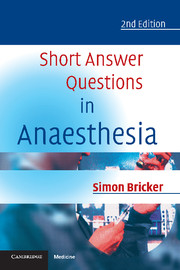Book contents
- Frontmatter
- Contents
- Preface
- Preface to the 1st edition
- Abbreviations
- 1 Advice on answering short answer questions
- 2 General Anaesthesia
- 3 Anaesthesia and Medical Disease
- 4 Medicine and Intensive Care
- 5 Obstetric Anaesthesia and Analgesia
- 6 Paediatric Anaesthesia
- 7 Neuroanaesthesia
- 8 Acute and Chronic Pain
- 9 Trauma and Emergency Anaesthesia
- 10 Anatomy, Applied Anatomy and Regional Anaesthesia
- 11 Pharmacology and Applied Pharmacology
- 12 Clinical Measurement and Equipment
- 13 Cardiac and Thoracic Anaesthesia
- Index
5 - Obstetric Anaesthesia and Analgesia
Published online by Cambridge University Press: 05 February 2014
- Frontmatter
- Contents
- Preface
- Preface to the 1st edition
- Abbreviations
- 1 Advice on answering short answer questions
- 2 General Anaesthesia
- 3 Anaesthesia and Medical Disease
- 4 Medicine and Intensive Care
- 5 Obstetric Anaesthesia and Analgesia
- 6 Paediatric Anaesthesia
- 7 Neuroanaesthesia
- 8 Acute and Chronic Pain
- 9 Trauma and Emergency Anaesthesia
- 10 Anatomy, Applied Anatomy and Regional Anaesthesia
- 11 Pharmacology and Applied Pharmacology
- 12 Clinical Measurement and Equipment
- 13 Cardiac and Thoracic Anaesthesia
- Index
Summary
A woman complains of persistent headache following a regional anaesthetic for obstetric delivery. What are the distinguishing clinical features of the likely causes?
Postpartum headache is common and is sometimes related directly to the anesthetic technique that has been used. It may be trivial or it may herald serious intracranial problems. Anaesthetists are asked frequently to review such patients and knowledge of the differential diagnosis is vital for all those who cover labour wards.
Introduction
Postpartum headache is common and is frequently, but not always trivial. For this reason a complaint of headache should always be taken seriously until its cause can be shown to be benign. The differential diagnosis includes:
Postdural puncture headache (PDPH) after inadvertent, unrecognised or deliberate dural puncture. Onset is variable: usually after 24 hours but may occur earlier or later. May be frontal or occipital rather than global. It is typically postural and relieved by recumbency or abdominal pressure. Associated with photophobia, visual disturbance, neck and shoulder stiffness, tinnitus, anorexia, nausea and vomiting. The patient may feel systemically very unwell. Presentation is not always typical.
Headache associated with pregnancy-induced hypertension (PIH). Generalised headache. No postural component. May be associated with visual disturbances (‘eclampsia’ comes from the Greek and means ‘to flash forth’). Other findings may include epigastric pain, proteinuria, oliguria, thrombocytopenia.
Subarachnoid haemorrhage (SAH) (associated with PIH). Severe headache of sudden onset. Photophobia. Decrease in conscious level (not invariable).
[…]
- Type
- Chapter
- Information
- Short Answer Questions in Anaesthesia , pp. 155 - 176Publisher: Cambridge University PressPrint publication year: 2002



